In Vancouver, Grattix boxes have been filtering toxic runoff for years. Now a federally funded program aims to spread the good earth
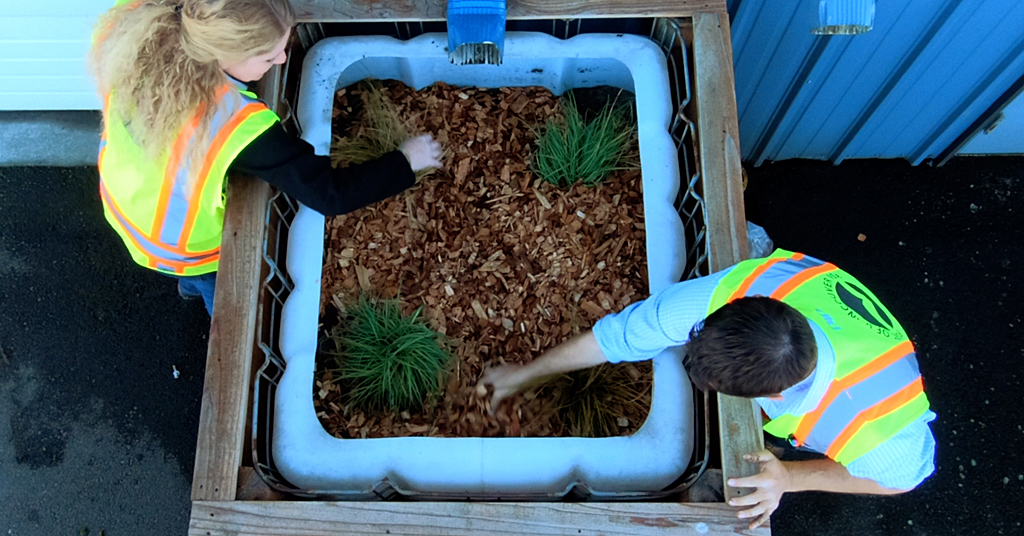
Copper catcher: Wanna know what’s going on inside this container? Keep scrolling. Photo: Port of Vancouver
By Jordan Rane. January 26, 2023. When it’s not coming down in vengeful buckets, rain can have the appearance of a cleansing effect on the land.
But for rivers, streams and neighboring water bodies inheriting all that mopped up motor oil, antifreeze, fertilizer, pesticides and other stormwater contamination, it’s another picture.
One of the most harmful, if less obvious, pollutants in this toxic brew is zinc.
The ubiquitous metal used as a rust deterrent in galvanized corrugated roofs, downspouts and other common building materials can wreak invisible havoc when leaching its way into rivers.
“It literally suffocates fish by binding to their gills and destroying tissue,” says Aaron Guffey, stormwater project manager with the Lower Columbia Estuary Partnership (LCEP), a nonprofit dedicated to protecting about 150 industry-saturated miles of the Lower Columbia River straddling Oregon and Washington. “When zinc gets into our streams and rivers, its effects on fish and other aquatic life are severe—including disrupted reproduction, cell damage, immune suppression, hormone disruption and developmental abnormalities.”
With the the Port of Vancouver as its hub, the Lower Columbia River’s dense industrial zone is zinc-land—a sprawl of galvanized infrastructure that can leach harmful heavy metals into the river after any given shower.
But the massive port, with its 50-plus industrial tenants sardined into four miles of commerce-run riverfront, has also for years been home to a cost-effective, innovative and underappreciated stormwater pollution solution.
Introducing the Grattix
Resembling an oversized box of dirt topped with some grassy plants, the Grattix may appear at a glance to be little more than some modest exterior decorating in factory-ville.
The disguised contraption—hatched and developed by members of the port’s on-site environmental team—has proven to be an effective means of controlling roof-runoff pollution.
That pollution is chiefly zinc, as well as copper, another industrial castaway harmful to aquatic life.
“During our pilot study program from 2008-2011, we collected several inlet and outlet samples on the Grattix and continuously saw 90% to 95% reduction in zinc in the stormwater runoff,” says Matt Graves, Port of Vancouver environmental manager.
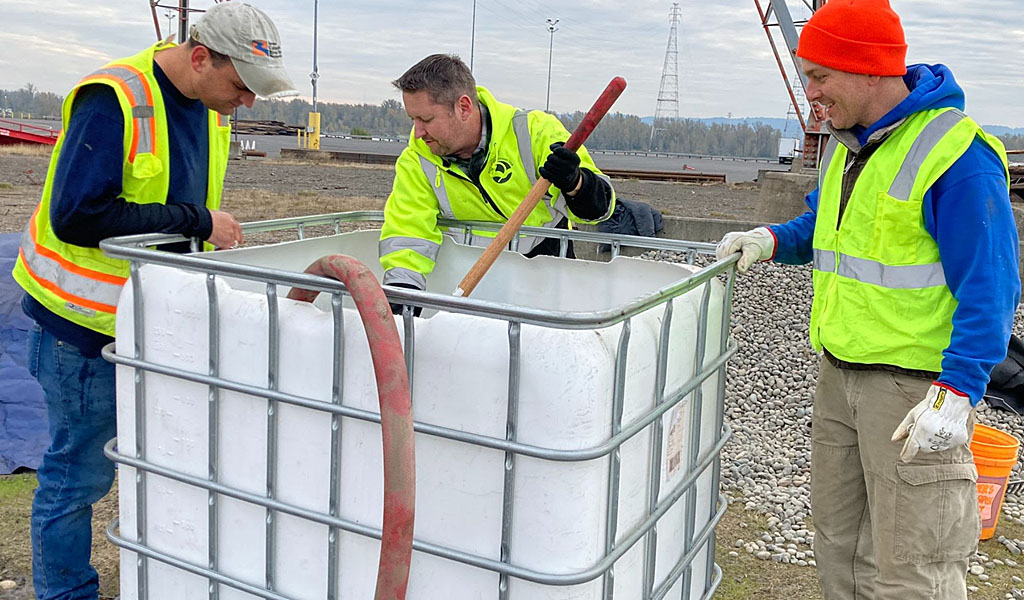
Cheap and easy: Building a Grattix is relatively simple. And inexpensive. Photo: Port of Vancouver
The pilot program eventually drew federal funding.
Announced in fall 2020, the Environmental Protection Agency awarded a grant of $67,597 to the Lower Columbia Estuary Project to manage an expanded Grattix project.
But the program met with delays.
“A combination of the pandemic and staff changes slowed progress,” says Guffey. “Up to this point, the Estuary Partnership has really only done background investigations.”
Guffey says the project is now in “full gear,” with the LCEP “making a major push in the next couple of months.”
The hope is to make inroads, and bring Grattix boxes, to businesses and communities in areas around Scappoose, Warren, St. Helens and Rainier on the Oregon side of the Columbia, and Woodland, Kalama, Longview and Kelso on the Washington side.
“All of the industrial activity within that stretch fits well with the application of a Grattix box,” he says. “It makes a very good place to start.”
Literal dream to reality
Matt Graves co-created the Grattix box with colleague Mary Mattix. (We’ll let you figure out how they came up with the name for their invention.)
The boxes were also tested on copper at the Port of Vancouver—reducing up to 85% of it in stormwater runoff.
“We’re always thinking of ways to protect the water and the land around the port,” says Mattix in a short video about the Grattix’s inception.
The concept came to Mattix in a dream.
“I took my idea to Matt, he got to work and soon enough we had it: an invention that filters water for rooftops using plants and local materials,” she says. “Basically, a rain garden in a box.”
Built with a 250-gallon, food-grade, plastic bulk container used to hold commodities like corn syrup, the Grattix is layered with precise ratios of mulch, bio-retention soil, sand and gravel. It’s outfitted with a filtration system of perforated PVC pipe and crowned with hardy, wetland-style plants (rushes and sedges) that can withstand both summer drought and excess moisture in fall and winter.
Placed under any downspout and watered by rooftop runoff, the Grattix “works similar to a bioretention facility,” says Graves.
As water percolates through the box, harmful sediments are filtered, while substances like zinc are absorbed by the plants.
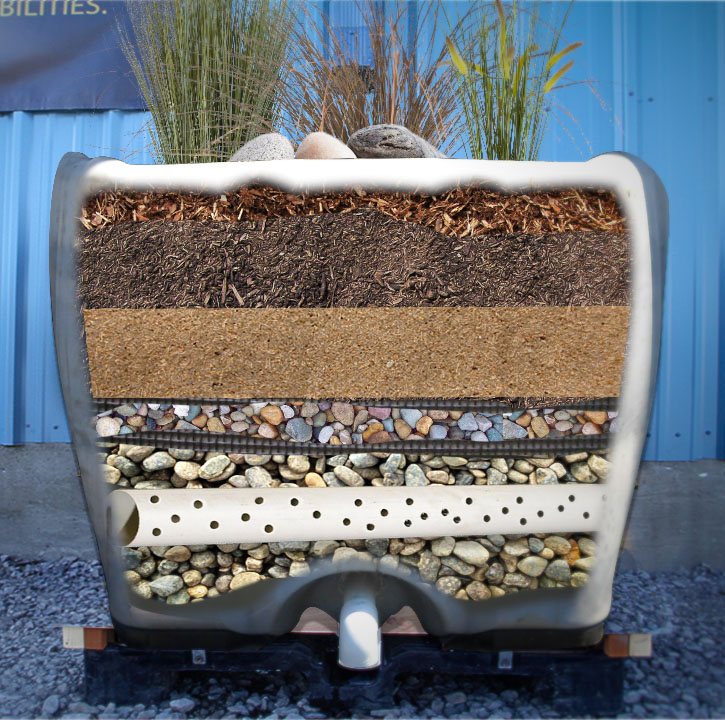
Cross-section: Grattix layers are meticulously measured and constructed. Photo: Port of Vancouver
The Grattix is pretty cheap—$800 if you include cosmetic wood framing around the plastic tub like they do at the port, but as low as $200 for a stripped down version.
It’s sustainable and virtually upkeep free.
“The only part that needs maintenance is the bark mulch top layer, which should be replaced annually,” says Graves. “The units themselves can otherwise last up to 30 years.
“Our first prototype was constructed out of a 55-gallon food-grade drum, which we quickly learned was way too small for our needs. We continue to adjust the layers and drainage, try new media and plants and tweak the aesthetics of the units. The project is continually evolving.”
And growing.
More than 50 Grattix units have been installed under downspouts throughout port.
These help manage zinc levels within the property’s state environmental permit requirements of 117 micrograms of zinc per liter, as well as 14 micrograms of copper—borne largely from what Graves calls “fugitive dust from industrial operations.”
Spreading the dirt
After years of success at the port, Grattix boxes are now starting to make their way downriver.
Helmed by the LCEP, the revived program aims to distribute free Grattix units to businesses along the Lower Columbia.
The project will receive 75% of its funding from the EPA.
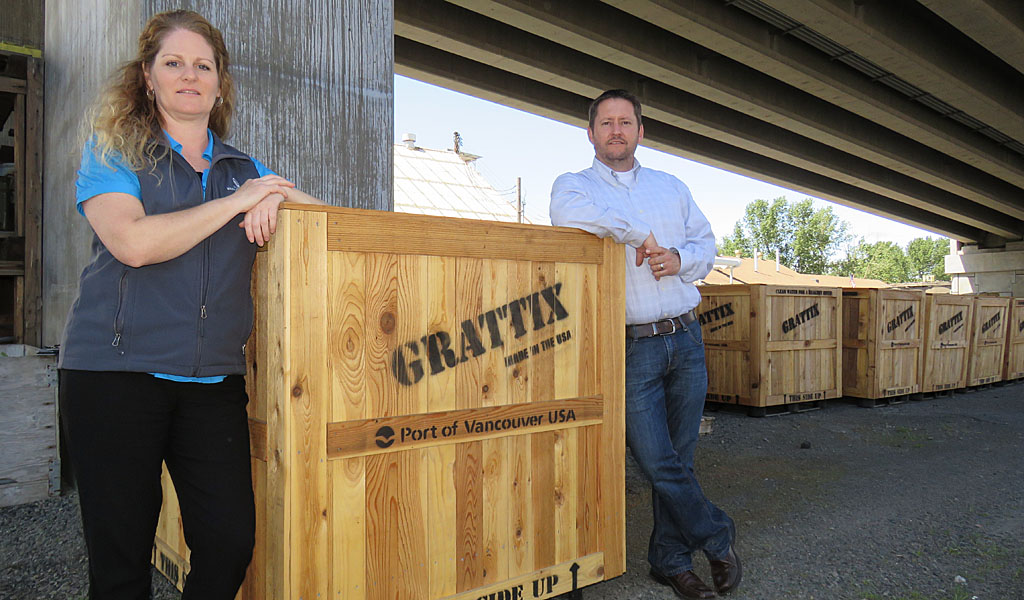
Thinking inside the box: Inventors Mary Mattix and Matt Graves. Photo: Port of Vancouver
“The Port of Vancouver originally developed these boxes to meet their own requirements, but they’ve been very open in sharing what they learned and motivated to inspire others,” says LCEP’s Guffey.
How transportable is the Grattix concept beyond its Lower Columbia River base?
“We get inquiries all the time from small businesses to large corporations to school students,” says Graves.
He has collaborated on an engineering project at his alma mater, Oregon State University, where teams of seniors built their own stormwater pollution-fighting boxes based on the Grattix template.
“They’re being used all over the Portland/Vancouver area, as well as elsewhere in Oregon and Washington, California, Virginia and Hawaii that we know about,” says Graves.
Some businesses, he says, are tailoring their own independent Grattix-type builds to address specific stormwater issues they’re trying to mitigate—similar to how it all began at the Port of Vancouver, but with a running start.
“Just like us at the port, others are adjusting the blends and medias that they put into a Grattix to suit their individual needs for performance and treatment,” says Graves. “People are getting really creative with it.”





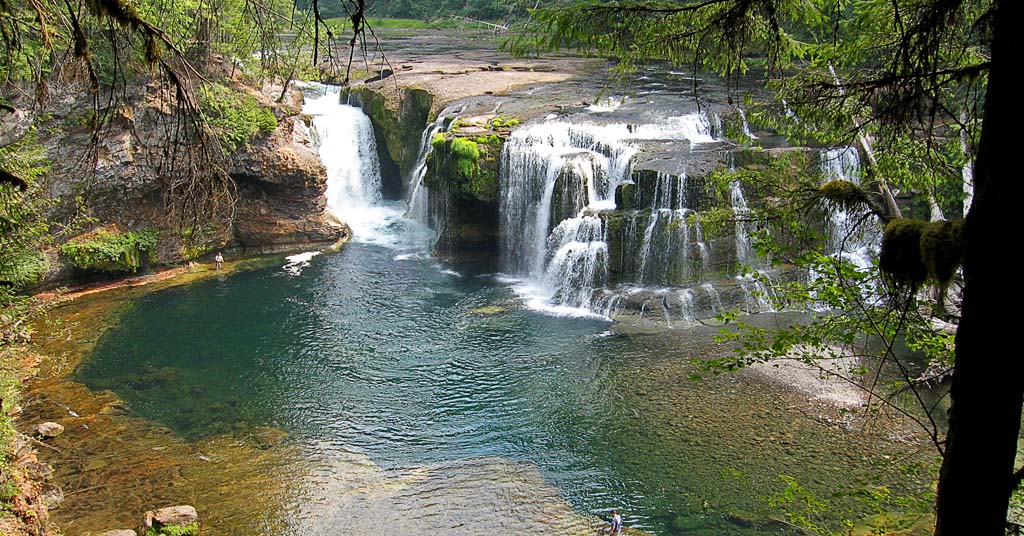

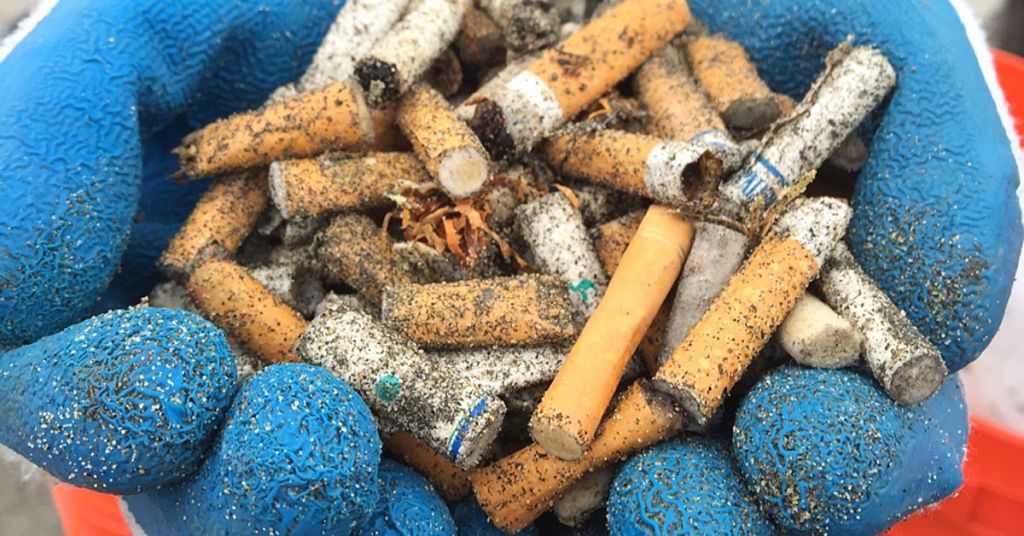



Very impressed with Matt and Mary.
Yes Matt really impressed me also.
Good article!
Was wondering if there are residential plans for home downspouts that diyers could build on site…size needed, layers, etc?
Thanks for any guidance.
Hi Marin, A much easier solution at home is a rain garden dug into the ground. Grattix boxes are a great tool on sites that are mostly paved. Rain gardens perform the same function using the soil in your yard, and have the added benefit of reducing stormwater quantity by infiltrating some of the roof runoff into the ground. Many new developments incorporate bioswales or retention ponds to accomplish the same thing – treatment before the runoff enters the watershed. Many local agencies and organizations provide guidance on designing and building a rain garden.
Nice article, Jordan. Where ultimately does all the zinc go after being bioaccumulated by the plants? Presumably the plants, when they die or are removed, are landfilled or composted, and not recontaminating stormwater runoff? Does effectiveness of the [closed] system diminish over time? If so, I wonder if replanting restores effectiveness.
Great question, Bonnie! The plants do uptake some contaminants, but the zinc and other compounds mostly adsorb to the compost blend in the box. The plant material can be safely composted, but the compost in the box should be landfilled after it is no longer effectively filtering out contaminants. Depending on what’s in the runoff, this would normally take many years or even a couple of decades. Assuming the rest of the box is still in good shape it could be refilled with fresh compost.
Nice process! Related to Bonnie’s question on the zinc-loving plants, I have a similar question on the top layer of mulch that is replaced annually. How is this disposed of, in order to not contaminate soil or water elsewhere?
Hi Lori, Similar to the compost blend, the top layer of mulch will adsorb compounds from the runoff that make it unsafe to compost, so the mulch should also be landfilled and replaced with fresh mulch. The top layer of mulch will degrade and become gunked up the most quickly, so it should be replaced annually.